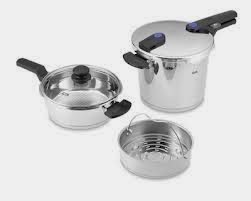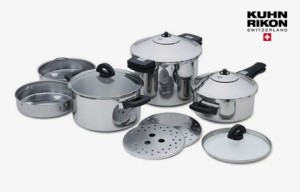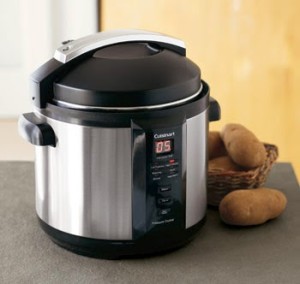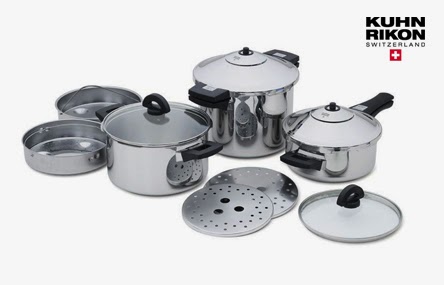Pressure cookers have been making a big comeback over the last decade. Gone are the days of a shaky pot spitting hot steam out at your face. Safety features abound and they’ve even gone from the stovetop to the countertop in many electric models.
How Does a Pressure Cooker Work?
A pressure cooker, stovetop or electric, has a gasket seal on the lid piece that makes it impossible for steam to escape from inside of the cooking vessel once locked into place. As you heat the water/food inside the vessel, the water turns to vapor. Since the steam cannot escape, its molecules will increase velocity, which will increase pressure on the surface of the liquid and the also increase the temperature of the water.*
Why Pressure Cook?
- Fast – steam cooks food faster than dry cooking methods
- Nutritional – steamed food retain vitamins and nutrients better than other cooking methods
- One pot – easy cleanup
- Braising – works well with foods that require water infusion or braising methods
- Safe – food is cooked above boiling point, killing most bacteria and micro-organisms
- Pressure Canning – if you get a large enough pressure cooker, you can also use it for pressure canning. Some people don’t trust themselves to get the time/temperature correct when using a regular pot for canning.
- Or purchase a pressure canner, which is essentially the same thing, it just won’t have the fancy handles and locks like a stovetop pressure cooker.
Most people really love pressure cookers for cooking beans, artichokes, and making soup stocks.
 |
| Fissler pressure cooker pans with pressure lid, glass lid and perforated insert pan |
Things to Consider With Both Stovetop and Electric Pressure Cookers:
- Gaskets wear out (like they would on anything requiring a gasket seal), so I would recommend making sure you can find replacement ones.
- On that note, making sure any parts are replaceable is key, in my opinion.
- Reviews on pressure cookers can be tough, because a lot of people are overwhelmed when they finally get it home, don’t use it properly, etc. Reviews on anything, in general, tends to be on the negative side since people with positive experiences don’t feel the urge to get online and complain! So make sure you really do your homework and check reviews from several sources. Cook’s Illustrated and Consumer Reports are high-quality resources.
- With something that can be considered so dangerous, I personally would spend more to get the top-rated brands. I don’t want to skimp on materials to save a couple of bucks!
- Find pressure cooker cookbooks that appeal to you. I would refer to something published versus a recipe you find on the internet (unless you know it’s a reputable source!), just like with canning (or pressure canning!) You don’t want to assume everyone knows their internal meat cooking temperatures, etc. At least this isn’t canning and you can always throw your food in a pot on the stove afterwards if it’s not cooked properly!
- The European Union has very strict standards on pressurized equipment (pressure equipment directive), so if you are still worried, I would look for a European brand to have comfort in knowing it has to be up to par.
- Everything has to be cooked at once, and some foods don’t taste quite right with the addition of water required to use the cooker.
- You have to reduce pressure just to inspect the food while cooking, so that is discouraged. It’s recommended to aim to undercook versus overcook, since you can always continue cooking if it’s not done yet.
 |
| Duromatic pressure cookers and accessories |
Stovetop Pressure Cookers
Stovetop pressure cookers aren’t what they used to be. Every model I have seen now comes with two ways to release the pressure buildup; a release button on the handle, and the old-school way, by running water over the lid.
All new stovetop pressure cooker lids are shaped in a way or designed in a way that forces the hot steam downwards, away from the cook’s face. They also won’t open until the pressure has been fully released.
You can use your pressure cooker pan as a regular pan without the lid, and my favorite brand, Fissler, actually makes a set that comes with a glass lid, a pressure lid, and two different sized pots that you can interchange the lids between for pressure and regular cooking. I know Kuhn Rikon sells the glass lids with certain cookers and separately. I’m sure other brands must also make glass lids, as well.
Fissler & Kuhn Rikon also make a bunch of really cool accessory pieces if you really want to get into using your pressure cooker as an essential kitchen tool. Who knew you could make a cheesecake in a pressure cooker?
Fissler is made in Germany. They have a unique indicator system that they’ve actually improved upon so you can really see what pressure level you are at; it uses the “traffic light” color model. Their newer models have cool features like an electronic digital readout and a pressure-free steam setting. They are also just very well-marked, making them almost fool-proof to get together and lock into place, unlike some other brands can be.
Kuhn Rikon’s Duromatic, is made in Switzerland. And yes, the pressure cookers are still made there, I know that a lot of their smaller gadgets are not. You can order replacement parts, so that is positive, as well. They’ve pretty much been producing the same cookers for a long time, so they are definitely sturdy and reliable, I just say they’re my second favorite because Fissler has so many cool features. They are both high quality pieces of kitchen equipment, and actually now that pressure cooking is becoming popular again, Kuhn Rikon are starting to revamp their wares again, so check them out!
Fagor is supposed to be a very good inexpensive alternative to these two, so I would recommend checking that brand out above anything else since it had a good rating with Cook’s Illustrated, but I personally have no knowledge about them.
 |
| Cuisinart electric pressure cooker |
Electric Pressure Cookers
Electric pressure cookers are a great ease if you have room for another countertop appliance in your home. The biggest difference from the stovetop is that you can’t use this as a regular pot on the stove. You can, however, use most of them as slow cookers. Depending on the settings yours comes with, you should also be able to brown or sauté, so you have the potential to use it without pressure.
The safety features on these should really just be that it won’t start unless it’s all locked into place properly. If you are doing slow release, you don’t even have to let the pressure out yourself, it does it for you. (Fast release, you push a lever.)
I am really only familiar with the Cuisinart model; most other models are very new to the market over the last decade and the companies producing them are constantly changing the machines so you generally never see the exact same ones twice. Cuisinart has been making pretty much the same model for longer than that, proving it’s sturdiness and reliability. You can buy replacement parts easily, it comes with a rack and a nice recipe book, along with a 3-year warranty.
* http://www.edinformatics.com/math_science/science_of_cooking/science_of_pressure_cooking.htm

